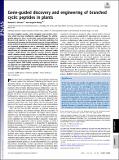| dc.contributor.author | Kersten, Roland D. | |
| dc.contributor.author | Weng, Jing-Ke | |
| dc.date.accessioned | 2020-04-15T17:12:54Z | |
| dc.date.available | 2020-04-15T17:12:54Z | |
| dc.date.issued | 2018-10-29 | |
| dc.identifier.issn | 0027-8424 | |
| dc.identifier.issn | 1091-6490 | |
| dc.identifier.uri | https://hdl.handle.net/1721.1/124661 | |
| dc.description.abstract | The plant kingdom contains vastly untapped natural product chemistry, which has been traditionally explored through the activity-guided approach. Here, we describe a gene-guided approach to discover and engineer a class of plant ribosomal peptides, the branched cyclic lyciumins. Initially isolated from the Chinese wolfberry Lycium barbarum, lyciumins are protease-inhibiting peptides featuring an N-terminal pyroglutamate and a macrocyclic bond between a tryptophan-indole nitrogen and a glycine α-carbon. We report the identification of a lyciumin precursor gene from L. barbarum, which encodes a BURP domain and repetitive lyciumin precursor peptide motifs. Genome mining enabled by this initial finding revealed rich lyciumin genotypes and chemotypes widespread in flowering plants. We establish a biosynthetic framework of lyciumins and demonstrate the feasibility of producing diverse natural and unnatural lyciumins in transgenic tobacco. With rapidly expanding plant genome resources, our approach will complement bioactivity-guided approaches to unlock and engineer hidden plant peptide chemistry for pharmaceutical and agrochemical applications. | en_US |
| dc.language.iso | en | |
| dc.publisher | Proceedings of the National Academy of Sciences | en_US |
| dc.relation.isversionof | 10.1073/pnas.1813993115 | en_US |
| dc.rights | Article is made available in accordance with the publisher's policy and may be subject to US copyright law. Please refer to the publisher's site for terms of use. | en_US |
| dc.source | PNAS | en_US |
| dc.subject | Multidisciplinary | en_US |
| dc.title | Gene-guided discovery and engineering of branched cyclic peptides in plants | en_US |
| dc.type | Article | en_US |
| dc.identifier.citation | Kersten, Roland D. and Jing-Ke Weng. "Gene-guided discovery and engineering of branched cyclic peptides in plants." Proceedings of the National Academy of Sciences of the United States of America 115 (2018): E10961-E10969 © 2019 The Author(s) | en_US |
| dc.contributor.department | Massachusetts Institute of Technology. Department of Biology | en_US |
| dc.contributor.department | Whitehead Institute for Biomedical Research | en_US |
| dc.relation.journal | Proceedings of the National Academy of Sciences of the United States of America | en_US |
| dc.eprint.version | Final published version | en_US |
| dc.type.uri | http://purl.org/eprint/type/JournalArticle | en_US |
| eprint.status | http://purl.org/eprint/status/PeerReviewed | en_US |
| dc.date.updated | 2020-02-03T17:33:50Z | |
| dspace.date.submission | 2020-02-03T17:33:52Z | |
| mit.journal.volume | 115 | en_US |
| mit.journal.issue | 46 | en_US |
| mit.license | PUBLISHER_POLICY | |
| mit.metadata.status | Complete | |
